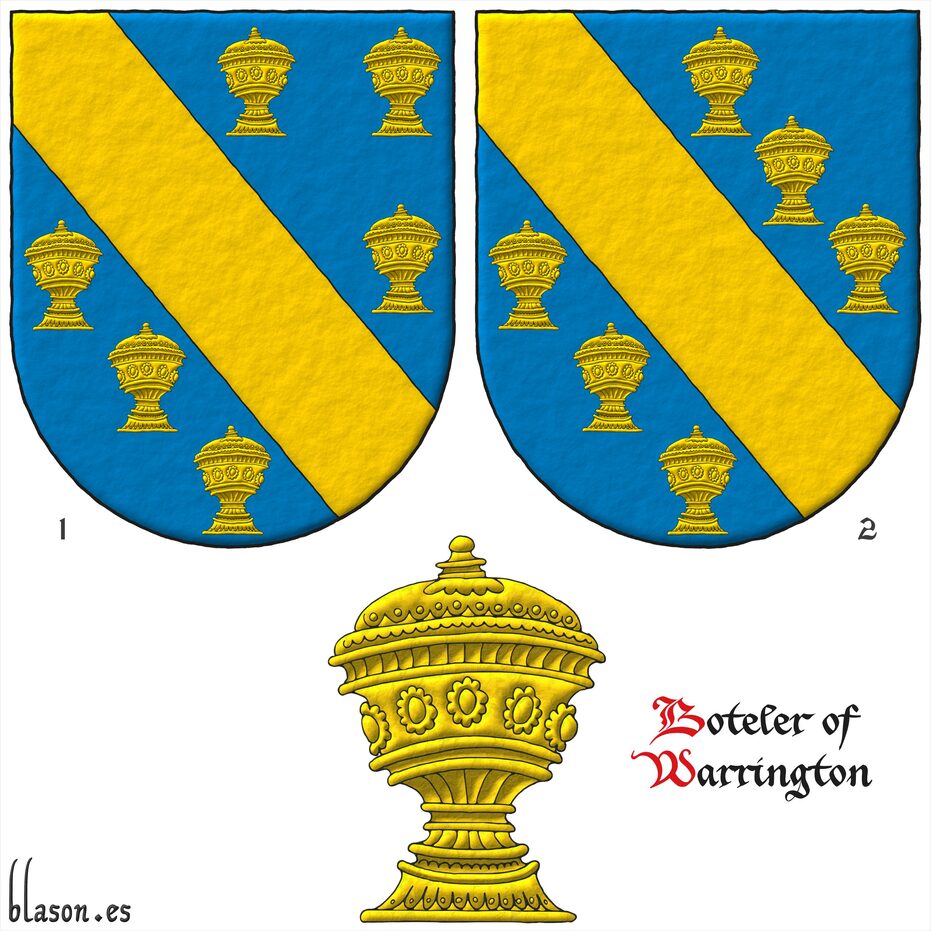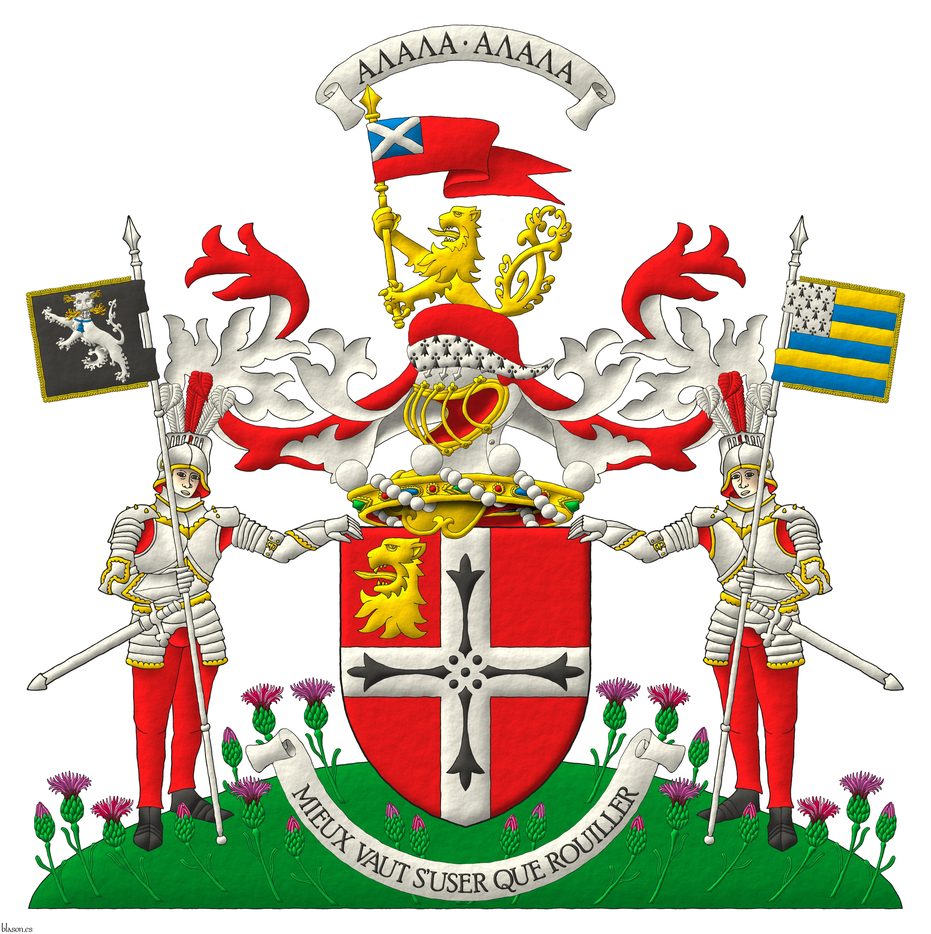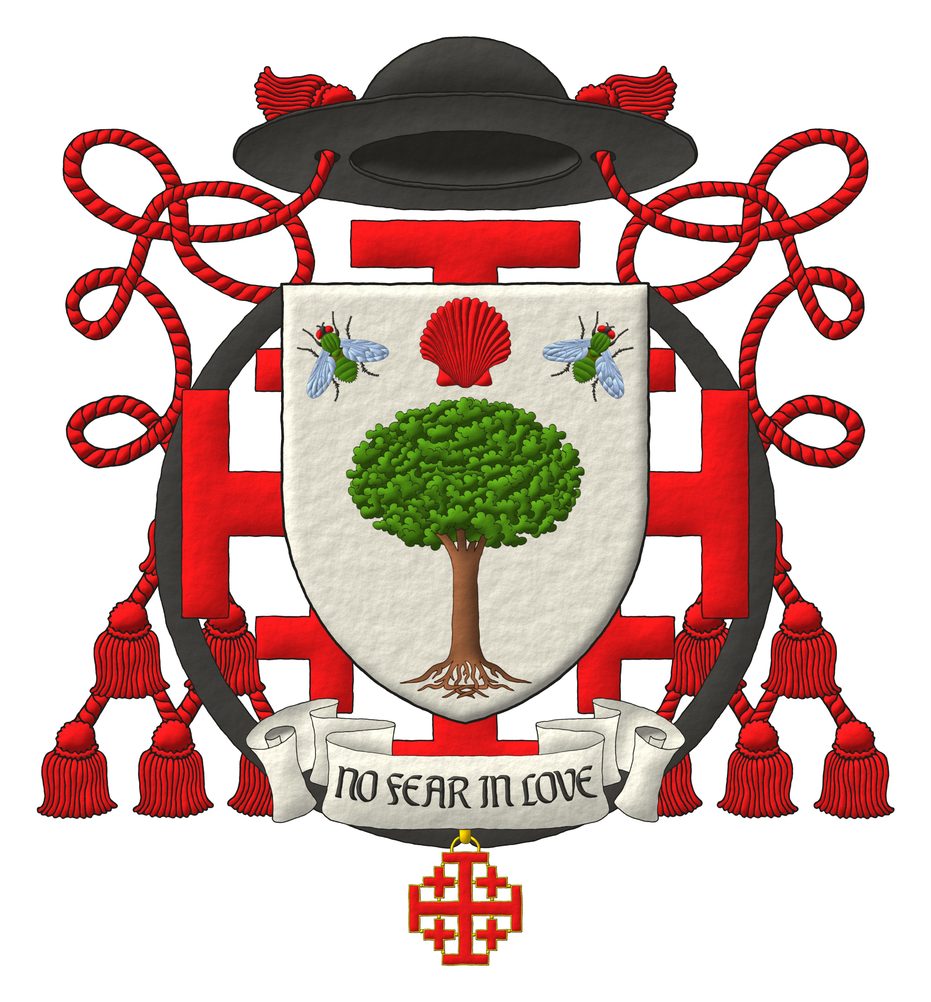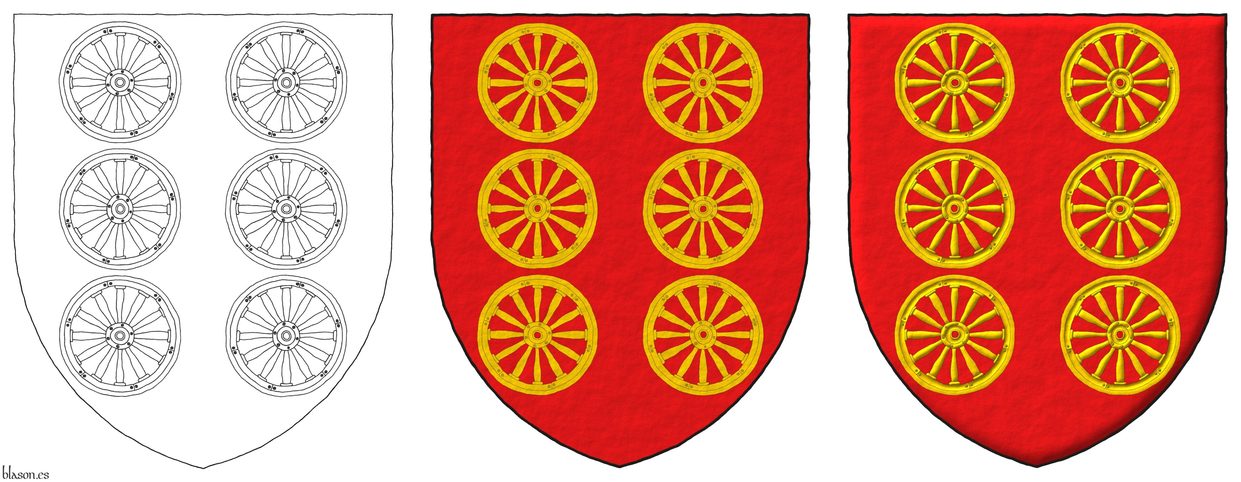Six


Adrian V

186th Pope of the Church, only 40 days in 1276. «Hadrianus V», born Ottobuono de Fieschi, was born in Genoa.
Bendy of six Azure and Argent.
Escudo bandado de seis piezas de azur y plata.
Papal coat of arms interpreted by me with: a shield with a rounded arch top; the field in plain tincture of Argent; the bands illuminated in Azure and outlined in Sable; and the whole in an elevated line style.
The blazon in French is «Bandé d'azur et d'argent de six pièces».
The banding is defined in [Avilés, J.; 1725a; page 40] and [Avilés, J.; 1780a; page 45] as the shields and also, the chiefs, fesses, pales, and figures, such as animals, etc., that are «covered and filled with bands in equal number, with as many of metal as of color».
Blazon keywords: Without divisions, Bendy, Six, Azure and Argent.
Style keywords: Semi-circular, Illuminated, Outlined in sable and Freehand.
Classification: Interpreted, Religious and Papal States.
Bearer: Adrian V.


Amitay Edward von Stiebel, plain tincture
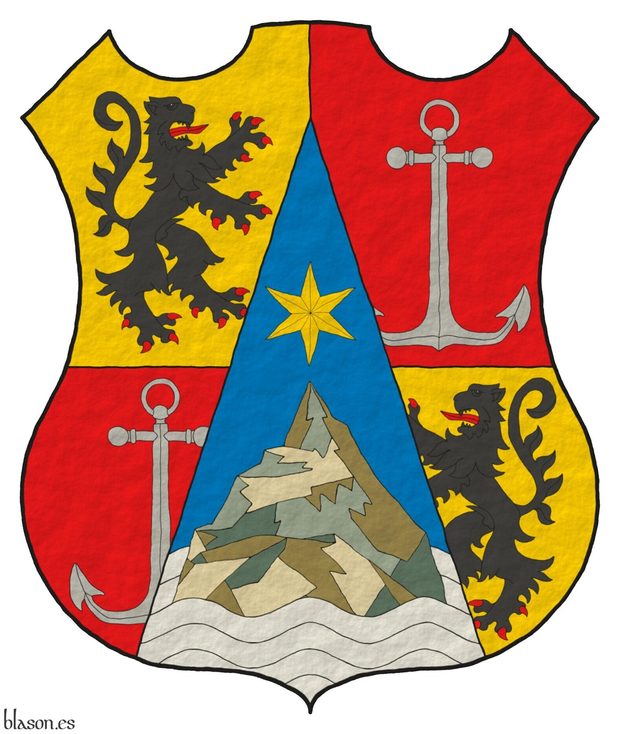
Quarterly: 1 Or, a lion rampant, facing sinister Sable, armed and langued Gules; 2 and 3 Gules, an anchor proper; 4 Or, a lion rampant Sable, armed and langued Gules; overall, a pile issuant from base Azure charged with a mount proper issuant from water issuant from base Argent, in chief, a mullet of six points Or.
Arms emblazoned by me, in flat tinctures, contoured in Sable, and with a texturized finishing.
Coat of arms of Amitay Edward von Stiebel emblazoned by me.
Blazon keywords: Or, Sable, Gules, Azure, Argent, One, Six, Quarterly, Lion, Rampant, Facing sinister, Armed, Langued, Anchor, Proper, Overall, Pile issuant from base, Charged, Mount, Issuant, Water, Issuant from base, In chief and Mullet.
Style keywords: Outlined in sable, Plain tincture and Bull's hide.
Classification: Personal, Interpreted, Boa and Coat of arms.
Bearer: Stiebel, Amitay Edward von.


Bosnia and Herzegovina
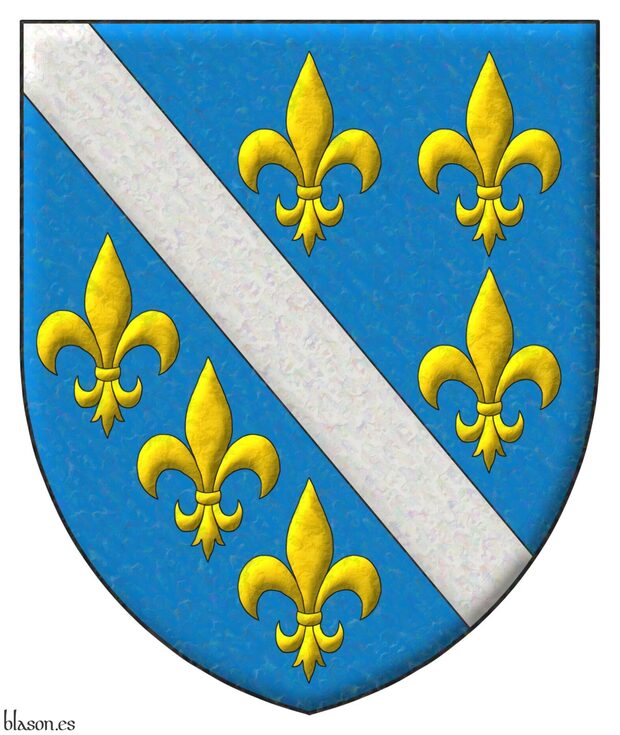
From 1992 to 1998
Azure, a bendlet Argent between six fleurs de lis Or.
Illuminated with lights and shadows and with a metallic and iridescent finish.
Coat of arms of Stephen Tvrtko I (circa 1338-1391) of the House of Kotromanic and 1st King of Bosnia and it was also the coat of arms of Bosnia and Herzegovina from 1992 to 1998.
The bendlet is a diminutive of the bend. It is a diminished bend, narrower, and typically reduced to 1/2 (as in this case) or to 1/3 of the width of a normal bend. This piece is called «cotiza» in Castilian, «cotice» in French, and «cotissa» in Italian. Remember that the width of the bend is usually 1/3 of the width of the coat of arms, therefore the width of the bendlet is between 1/3 * 1/2 = 1/6 and 1/3 * 1/3 = 1/9 of the width of the coat of arm.
Stephen Tvrtko I of Bosnia, from the House of Kotromanic, was a vassal of Louis I of Hungary. Louis I or Louis of Anjou, known as «the Great», from the Royal House of Anjou-Sicily, of the Capetian Dynasty, hence his coat of arms's 2nd quarter is seeded with fleur de lis, a feature also present in his father Charles I's arms, known as Charles Robert or Caroberto of Anjou. The Kotromanic family had in their coat of arms fleur de lis Or on a Azure field as a symbol of subordination to the Hungarian royal family.
Blazon keywords: Azure, One, Bendlet, Argent, Six, Fleur de lis and Or.
Style keywords: Metal beaten, Iridescent, Outlined in sable, Illuminated and Pointed.
Classification: Civic, Interpreted and Coat of arms.
Bearer: Bosnia and Herzegovina.


Boteler of Warrington

Azure, a bend between six covered cups Or.
Escudo de azur, una banda acompañada de seis copas todo de oro.
Illuminated with lights and shadows and with a freehand finish.
Around 1155, Beatrix de Villers married Richard le Boteler Pincerna, who became the 4th Baron of Warrington. The heir of Beatrix and Richard took the surname «le Boteler» and ruled the Warrington region, bearing arms Azure, a bend between six covered cups Or.
In Castilian, a «copa» has a lid and is referred to as a «covered cup» in English. When it doesn't have a lid, it's called a «cup» in English and a «cáliz» or «copón» in Castilian, the latter being a less preferred term for me. In English, the term «chalice» is also used, especially if it's adorned with gemstones, although that's more of an artistic license.
Naipes Heraclio Fournier is a renowned Spanish playing card manufacturer based in Villareal de Álava. The countless hours I have spent holding its cards in my hands are incalculable, whether playing with friends, opponents, or performing magic tricks. Its influence on my heraldic artwork is significant. For instance, in this covered cup.
The following image shows my covered cup and my two interpretations of his arms: 1) the most commonly viewed, and 2) my alternative layout.
Blazon keywords: Without divisions, Azure, One, Bend, Between, Six, Covered cup and Or.
Style keywords: Freehand, Outlined in sable, Illuminated and Semi-circular.
Classification: Interpreted and Kingdom of England.
Bearer: Boteler of Warrington.


Clement XII
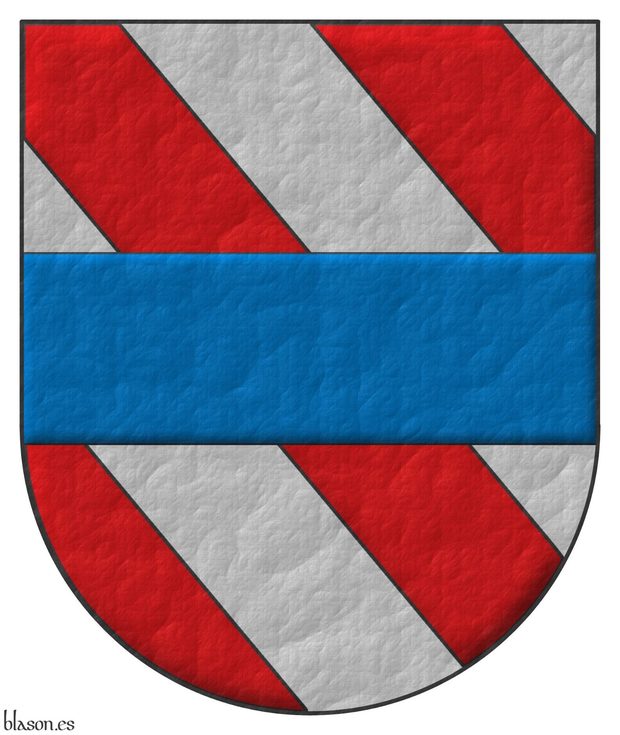
246th Pope of the Church, from 1730 to 1740. «Clemens XII», named Lorenzo Corsini, born in Florence and rests in St. John Lateran.
Bendy of six Gules and Argent; over all a fess Azure.
Escudo bandado de seis piezas de gules y plata; brochante sobre el todo una faja de azur.
Papal coat of arms interpreted with: a rounded mouth; the field in flat tincture of Argent; the fess and the bands outlined in Sable and illuminated in Gules and Azure; and the whole with a textured finish.
All are ordinaries, including the three bands and the fess, and since the blazon specifies that the fess is overall on the bands, therefore, it is not the Gules bands that are overall on the Azure fess, and they should be painted underneath.
Blazon keywords: Without divisions, Bendy, Six, Gules, Argent, Surmounted, Overall (deprecated), One, Fess and Azure.
Style keywords: Semi-circular, Illuminated, Outlined in sable and Freehand.
Classification: Interpreted, Religious and Papal States.
Bearer: Clement XII.


Coat of arms of Elias Yñigo-Genio
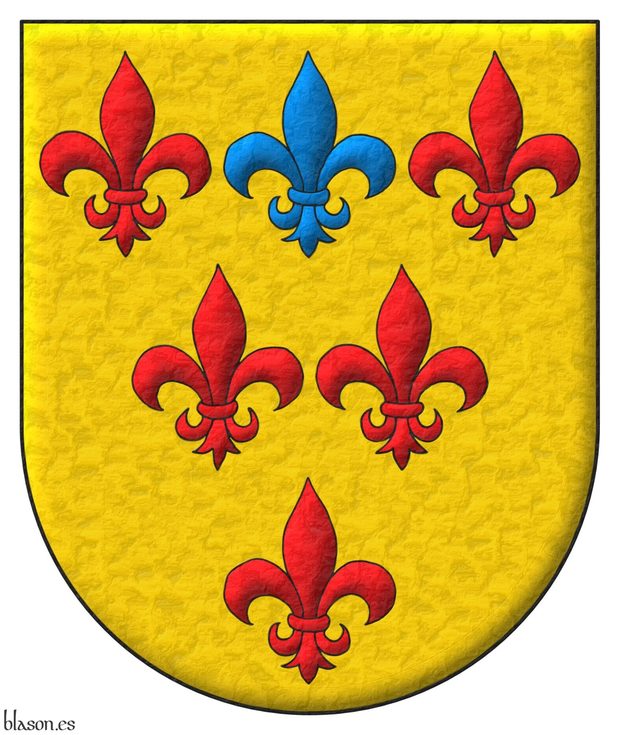
Or, six fleurs de lis, three, two, one, five Gules and one in the middle of the chief Azure.
Escudo de oro, seis flores de lis ordenadas, tres, dos y una, cinco de gules y una de azur en el centro del jefe.
Credits:
- Rolando Yñigo-Genio is the designer of the coat of arms.
- Antonio Salmerón y Cabañas is the author of the heraldic art.
Blazon keywords: Or, Six, Fleur de lis, Ordered, Three, two and one, Five, Gules, One, Azure and In the middle of the chief.
Style keywords: Semi-circular, Soft metal, Outlined in sable and Illuminated.
Classification: Interpreted, Personal and Coat of arms.
Bearer: Yñigo-Genio, Elias.


Coat of arms of Noelia Yñigo-Genio
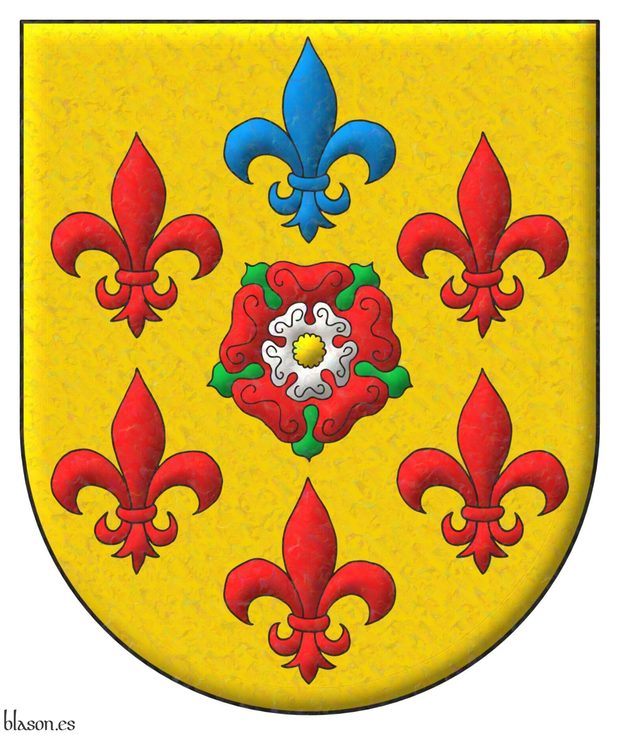
Or, a double rose Gules and Argent, barbed Vert, and seeded Or within six fleurs de lis in orle, five Gules and one in chief Azure.
Escudo de oro, una rosa doble de gules y plata, barbada de sinople y botonada de oro, rodeada de seis flores de lis en orla, cinco de gules y una de azur en jefe.
Credits: Rolando Yñigo-Genio is the designer of the coat of arms and Antonio Salmerón y Cabañas is the author of the heraldic art.
Blazon keywords: Or, Double rose, Gules, Argent, Barbed, Vert, Seeded, Six, Fleur de lis, Orle, Five, One, Azure and In chief.
Style keywords: Semi-circular, Iridescent, Outlined in sable and Illuminated.
Classification: Interpreted, Personal and Coat of arms.
Bearer: Yñigo-Genio, Noelia.


Crest, mantling and motto of Rex Lancefield
Paly of six Gules and Argent; overall, a fess Or charged with a lance Gules. Crest: Upon a helm with a wreath Argent and Gules, an arm vambraced, bendwise Argent, grasping, bend sinisterwise, a bow Gules, cord Or, and an arrow point sinister Argent. Mantling: Gules doubled Argent. Motto: «Inter Primos».
Arms depicted by me, illuminated with lights and shadows, contoured in Sable, with a chasuble outer contour and with a freehand finishing.
Blazon keywords: Gules, Argent, Or, Six, One, Paly, Overall, Fess, Charged, Spear, Crest, Upon (wreath), Helm, Lined, Wreath, Arm, Vambraced, Bendwise, Grasping, Bend sinisterwise, Bow, Cord, Arrow, Point sinister, Mantling and Motto.
Style keywords: Outlined in sable, Illuminated, Chasuble and Freehand.
Classification: Personal, Interpreted, Boa and Coat of arms.
Bearer: Lancefield, Rex.


Crown and motto of the Jean-Philippe Sendat

Gules, a lion rampant Or, langued and armed Vert; a bordure Azure charged with six escallops Argent. Crest: A crown. Moto: «Vade Fortis Anime».
Coat of arms emblazoned by me, illuminated with lights and shadows, outlined in Sable, with a pointed outer contour and with a leather finishing.
Blazon keywords: Gules, Or, Vert, Azure, Argent, One, Six, Lion, Rampant, Langued, Armed, Bordure, Charged, Escallop, Crown and Motto.
Style keywords: Outlined in sable, Illuminated, Pointed and Leather.
Classification: Personal, Interpreted, Boa and Coat of arms.
Bearer: Sendat, Jean-Philippe.


Crown of Gozo

Argent, upon a base barry wavy of six Argent and Sable, a trimount Sable. Crest: A mural crown Or.
Arms emblazoned by me, highlighted with lights and shadows, contoured in Sable, and with a freehand finish.
Blazon keywords: Argent, Sable, One, Six, Upon, Base, Barry, Wavy, Trimount, Crest, Mural crown and Crown.
Style keywords: Outlined in sable, Illuminated, Bull's hide and Freehand.
Classification: Civic, Interpreted, Boa and Coat of arms.
Bearer: Gozo.


Farnese, Alessandro
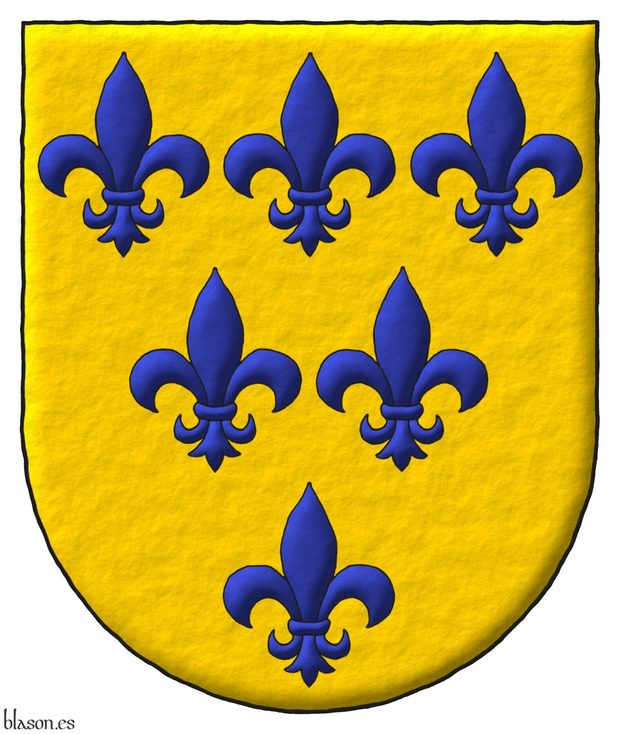
Or, six fleurs de lis Azure, 3, 2, and 1.
Escudo de oro, seis flores de lis de azur, 3, 2 y 1.
Coat of arms depicted by me, highlighted with lights and shadows, contoured in Sable, with a semi-circular outer contour and with a freehand finish.
Coat of arms of Alessandro Farnese, 1545–1592, emblazoned by me. In 1956, the fourth Tercio of the Spanish Legion was created and named Tercio Alessandro Farnese in his honor. The coat of arms of that Tercio features the arms of the Farnese in its central inescutcheon, although with its 6 fleurs de lis arranged in orle.
Blazon keywords: Or, Azure, Six and Fleur de lis.
Style keywords: Outlined in sable, Illuminated, Semi-circular and Freehand.
Classification: Personal, Interpreted, Boa and Coat of arms.
Bearer: Farnese, Alessandro.


Full achievement of Andrew Ronald McMillan Bell of Auchinreoch
Gules, a cross Argent charged with four ermine spots in cross Sable, in the dexter of the chief a lion’s head erased Or. Crest: Upon a helm befitting his degree issuant from a crown of Baron above the shield, with a chapeau Gules turned up ermine, a demi-lion, double queued Or, grasping in its dexter paw a pennon Gules, bearing a canton Azure, charged with a saltire Argent. Mantling: Gules doubled Argent. War cry above the crest: «ΑΛΑΛΑ ΑΛΑΛΑ». Motto: «Mieux vaut s’user que rouiller». Supporters: Two knights in three-quarter armour affronty proper, each holding with his outer hand a spear Argent bearing a banner, the dexter Sable, a panther rampant guardant Argent, incensed Or, collared, pendent therefrom a bell Azure, the sinister a banner barry of six Or and Azure, a canton Ermine, terraced Vert semé of Maltese Rock Centaury (Cheirolophus crassifolius) slipped proper.
Arms interpreted by me, illuminated with lights and shadows, contoured in Sable, with a pointed outer contour and with a freehand finish.
G0116, Chief Herald of Arms of Malta's grant for the arms of Andrew Ronald McMillan Bell of Auchinreoch, United Kingdom. These arms have been emblazoned by me for such grant. The English term «terraced», sometimes used in blazon, is equivalent to the term «compartment». In Castilian blazon we use the term «terrazado», in this case as an element outside the shield, while «terrazado» also exists inside the shield in base.
Blazon keywords: Gules, Argent, Sable, Or, Azure, Vert, One, Four, Six, Cross, Charged, Ermine, In cross, Dexter, Chief, Lion, Head, Erased, Crest, Upon (wreath), Helm, Issuant, Crown of Baron, Crown, Above the shield, Chapeau, Demi, Double queued, Grasping, Canton, Saltire, War cry, Above the crest, Motto, Supporter (human form), Supporter, Knight, Affronty, Proper, Spear, Panther, Rampant, Guardant, Enflamed, Collar, Suspended, Bell, Barry, Compartment, Semé and Slipped.
Style keywords: Outlined in sable, Illuminated, Pointed and Freehand.
Classification: Personal, Interpreted, Boa, Coat of arms, Pennon, Flag and Banner of arms.
Bearer: McMillan Bell of Auchinreoch, Andrew Ronald.


Full achievement of the Reverend John Muscat
Argent, a tree eradicated proper, in chief an escallop reversed Gules, between two flies pilewise proper. Crest: A galero Sable with two cords, one on each side, each with six tassels Gules. Motto: «No Fear In Love». Behind the shield, the cross of the Holy Sepulchre of Jerusalem. The shield is surrounded by the cross of a Knight Commander of the Holy Sepulchre of Jerusalem.
Arms interpreted by me, highlighted with lights and shadows, contoured in Sable, with a pointed external shape and with a freehand finish.
G0117, Chief Herald of Arms of Malta's grant for the arms of the Reverend John Muscat, Honorary Monsignor of the Canon Chapter, Roman Catholic Cathedral of the Assumption, Gozo. These arms have been emblazoned by me for such grant.
Blazon keywords: Argent, Gules, One, Two, Six, Tree, Eradicated, Proper, In chief, Escallop, Between, Fly, Pilewise, Crest, Galero, Cord, Tassel, Motto, Behind the shield, Cross, Surrounded and Decoration.
Style keywords: Outlined in sable, Illuminated, Pointed and Freehand.
Classification: Religious, Interpreted, Boa and Coat of arms.
Bearer: Muscat, John.


Geoffrey Plantagenet

Azure, six lions rampant Or, 3, 2 and 1.
Escudo de azur, seis leones rampantes de oro, 3, 2 y 1.
Existing armories interpreted by me as follows: the shape of the shield is pointed; the field has been enameled in flat azure; the 6 lions are illuminated and cast shadows on the field; and the entire composition has a hammered metal finish.
The shield of Geoffrey V, Count of Anjou is considered the first documented coat of arms in history, dated to 1127, when Henry I of England gifted it to him on the occasion of his marriage to his daughter Matilda of England [The Heraldry Society; 2013].
There is no direct evidence that Henry I possessed a coat of arms, nor that it featured a rampant lion [Humphery-Smith, C.; 1983], but the gift of a shield with 6 lions to his future son-in-law could be an indication of such.
Geoffrey is buried in the Cathedral of Saint Julian in Le Mans, and his tomb is decorated with an enamel depicting him with his shield, where of his 6 lions: 4 are fully visible, and 2 are suggested by their claws.
However, it is possible that both the wedding gift narrative and the enamel on the tomb are from years after his death in 1151, so [Pastoureau, M.; Garvie, F.; 1997; page 18] asserts that «this account was written after Geoffrey's death... and his funerary enamel commissioned by his widow Matilda between 1155 and 1160... therefore it is possible that Geoffrey Plantagenet never had a coat of arms».
Blazon keywords: Without divisions, Azure, Six, Lion, Or, Rampant and Three, two and one.
Style keywords: Pointed, Illuminated, Shaded, Outlined in the field tincture and Metal beaten.
Classification: Interpreted, Personal, Coat of arms and House of Plantagenet.
Bearer: Godfrey V, Count of Anjou.


Herbert Leo Buffenbarger, carved wood
Barry of six, Argent and Azure, a pile throughout, counterchanged. Crest: Upon a trimount Gules, an eagle wings addorsed and inverted Azure, the head and tail Argent, nimbed Or, grasping a closed book also Or. Mantling: Azure doubled Argent. Motto: «Buffenbarger».
The coat of arms of Herbert Leo Buffenbarger, designed by his son John Alan Francis Buffenbarger, carved in wood by James Allott based on my painting of it.
Blazon keywords: Argent, Azure, Gules, Or, One, Six, Three, Barry, Counterchanged, Pile, Throughout (chief base), Chaussé, Crest and mantling, Crest, Upon (wreath), Helm, Wreath, Upon, Trimount, Eagle, Wing, Addorsed, Head, Tail, Nimbed, Grasping, Closed book, Book, Mantling and Motto (identification).
Style keywords: Outlined in sable and Illuminated.
Classification: Personal, Interpreted, Boa, Carved wood, Collage and Photographic.
Bearer: Buffenbarger, Herbert Leo.


Innocent IV
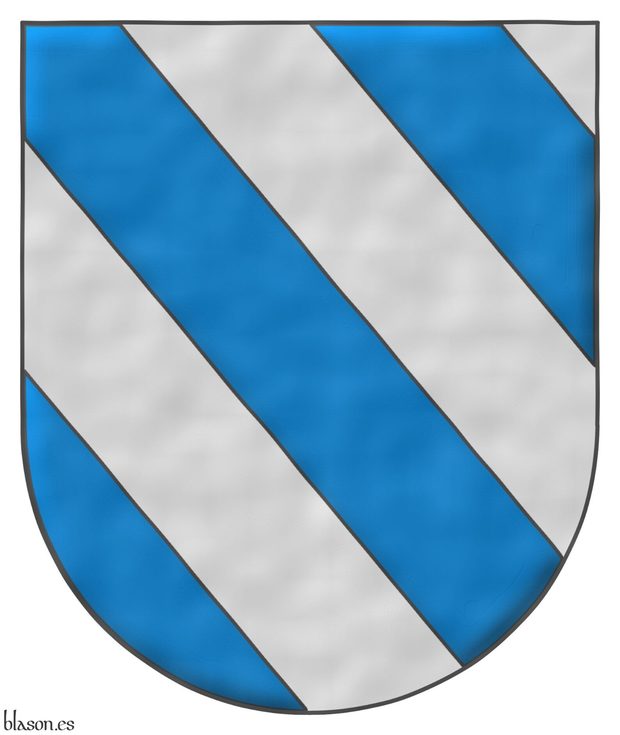
180th Pope of the Church, from 1243 to 1254. «Innocentius IV», born Sinibaldo dei Fieschi, was born in Manarola in northwest Italy.
Bendy of six Azure and Argent.
Escudo bandado de seis piezas de azur y plata.
Papal coat of arms interpreted by me with: a semicircular shield shape; a plain Argent field; bands illuminated in Azure and outlined in Sable; and the whole design with a watercolor finish.
Order of tinctures
In the bendy pattern, the tinctures are named starting from the one located at the dexter base of the shield and following an ascending sequence towards the sinister chief, although the most orthodox approach is to have only 2 tinctures, being one color and one metal.
Number of bands
It is said that it is not necessary to specify the number of bands when there are precisely 6, as in this case, and that it should be specified when there are, for example, 4 or 8. I have chosen to specify it for greater clarity of the blazon.
About the bendy pattern and the need to specify or not specify the number of its pieces, [Avilés, J.; 1725a; pages 40 and 41] and [Avilés, J.; 1780a; pages 45 and 46] say that it is «composed of four, six, or eight bends; in such a way that there are as many colors as metals, always specifying the number four and eight bands when blazoning, and not the one composed of six, as it is understood thus, without declaring the number of pieces» and without agreeing with it, and by its wording I believe that he is not entirely in agreement either, he adds «the reason that may exist for not specifying the number of six bends (although the authors do not express it) is that as the bend is one-third of the shield; and having six pieces, or six bends, the resulting number is doubled, as if the three parts were divided, which implies that the shield is filled with three bends; and taking the denomination of the figure infers, that the bendy is of six pieces: which does not happen with this equality in those of four and eight, requiring other proportions and consequently it becomes necessary to specify their number», therefore, note that the bendy of 6 does not follow the proportions of the bend, nor do those of 4 or 8, the only differential property of the one of 6 is being a multiple of 3, being 1/3 the width of the bend.
Blazon keywords: Without divisions, Bendy, Six, Azure and Argent.
Style keywords: Semi-circular, Illuminated, Outlined in sable and Watercolor.
Classification: Interpreted, Religious and Papal States.
Bearer: Innocent IV.


Lorena Correa, page of armorial

Party per pale: 1 quarterly: 1 Azure, a lion rampant Or, 2 Argent, a falcon rising, grasping in its paws a serpent Sable, 3 Or, a tower Azure, port, windows, and masoned Sable, 4 Gules, a fox passant Or, a chief Gules semé of mullets Argent; 2 Orange, a mullet of six points voided, interlaced Sable. Crest: A crown of the Sovereign and Most Noble Order of the Pomegranate. The shield is surrounded by the Grand Collar of the Sovereign and Most Noble Order of the Pomegranate.
This is her coat of arms of emblazoned by me for the Roll of Arms of the Sovereign and Most Noble Order of the Pomegranate.
Blazon keywords: Party per pale, Quarterly, Azure, One, Lion, Rampant, Or, Argent, Falcon, Rising, Grasping, Claw, Serpent, Sable, Tower, Port and windows, Masoned, Gules, Fox, Passant, Chief, Semé, Mullet, Five, Base (lower 1/3), Orange, Six, Voided, Interlaced, Crest and mantling, Crown, Pomegranate, Surrounded and Grand collar.
Style keywords: Ogee, Outlined in sable, Illuminated and Leather.
Classification: Personal, Interpreted, Coat of arms, Armorial roll and Castilian language.
Bearer: Correa, Lorena.


Malka Gittel Bas Reuven, page of armorial
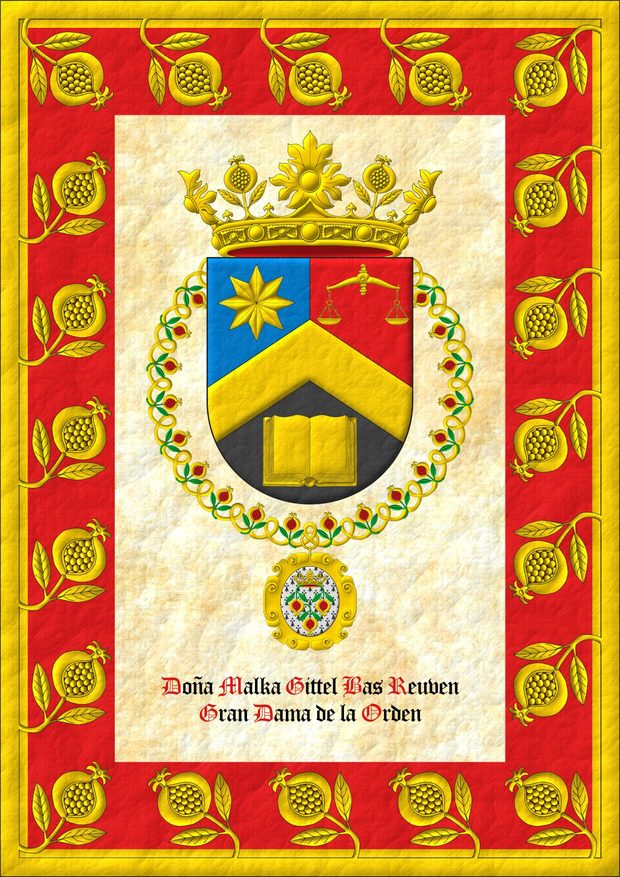
Tierced pallwise inverted Azure, Gules, and Sable; overall a chevron between, in the dexter of the chief, a mullet of six points, in the sinister of the chief a pair of scales, and in base an open book Or.
It has been painted by me, illuminated with lights and shadows, contoured in Sable, with a semi-circular outer contour and with a texturized finish.
Coat of arms of Her Excellency Ratu Muda Malka Bas Reuven emblazoned by me with for the Roll of Arms of the Soberana y Muy Noble Orden de la Granada.
Blazon keywords: Azure, Gules, Sable, Or, One, Six, Tierced pallwise inverted, Overall, Chevron, Between, Dexter, Chief, Mullet, Sinister, Pair of scales, In base, Open book, Book, Crown of the Sovereign and Most Noble Order of the Pomegranate, Crown, Surrounded and Collar.
Style keywords: Outlined in sable, Illuminated and Semi-circular.
Classification: Personal, Interpreted, Boa, Armorial roll and Castilian language.
Bearer: Gittel Bas Reuven, Malka.


Pius V
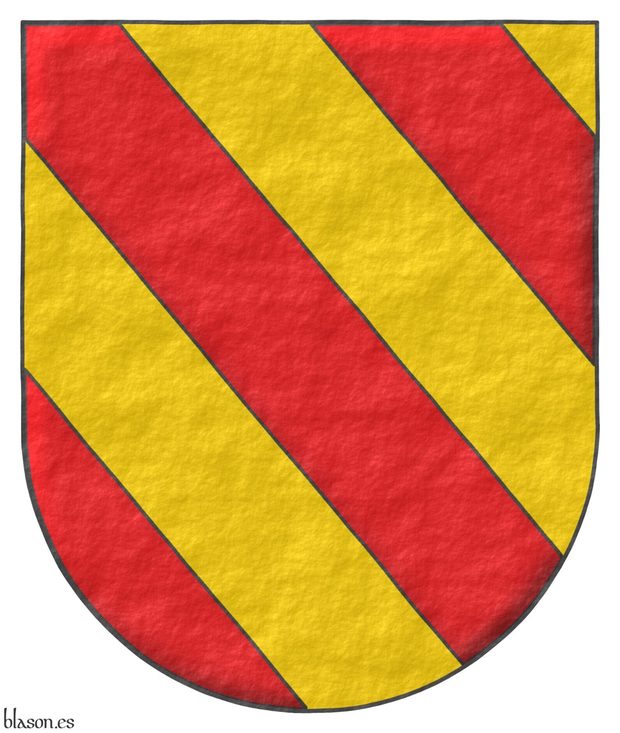
225th Pope of the Church, from 1566 to 1572. «Pius V», named Antonio Michele Ghislieri, was canonized in 1712.
Bendy of six Gules and Or.
Escudo bandado de seis piezas de gules y oro.
Papal coat of arms interpreted with: a rounded mouth; the field in flat tincture of Or; the bands outlined in Sable and illuminated in Gules; and the whole with a rough finish.
I have also seen this coat of arms described as «a shield banded of six pieces of Or and Gules».
Blazon keywords: Without divisions, Bendy, Six, Gules and Or.
Style keywords: Semi-circular, Illuminated, Outlined in sable and Rough.
Classification: Interpreted, Religious and Papal States.
Bearer: Pius V.


Richard de Bures tricking, hatching and plain tincture
Or, six annulets Gules, 3, 2, and 1.
Blazon keywords: Or, Six, Annulet, Gules, Ordered, Three, Two and One.
Style keywords: Outlined in sable, Semi-circular, Tricking, Hatching and Plain tincture.
Classification: Religious, Military, Knights Templar, Interpreted, Coat of arms and Schema.
Bearer: Richard, Richard.


Rui J. Vaz, schema 2x3
Party per pale Azure and Gules, overall a lion rampant Argent, winged Or, grasping in his dexter forepaw a sword erect Or. Crest: Upon a helm lined Gules, its bevor charged with a Latin cross patty and pierced with a Latin cross, and with a wreath Argent and Gules, a dexter winged forepaw Or, grasping an escutcheon quarterly: 1 Azure, a god Garuda sejant Argent; 2 Gules, a castle triple-towered Or, masoned Sable; 3 Argent, six pallets Gules; 4 Azure, five plates. Mantling: Gules doubled Argent. Motto: «Audacia,Veritas et Libertas».
Coat of arms of the family of Rui J. Vaz, US, designed by him and emblazoned by me. The image shows the arms with and without the motto, with and without the scroll, and 4 different ways of painting the scroll to see how it harmonizes more with the tilted shield, with the last one being chosen.
Blazon keywords: Azure, Gules, Argent, Or, One, Six, Five, Party per pale, Overall, Lion, Rampant, Winged, Grasping, Dexter, Forepaw, Sword, Erect, Crest, Upon (wreath), Helm, Wreath, Escutcheon, Quarterly, Garuda, Sejant, Castle, Triple-towered, Masoned, Pallet, Plate, Mantling, Doubled, Motto and Scroll.
Style keywords: Tilted shield, Outlined in sable, Plain tincture and Semi-circular.
Classification: Personal, Interpreted, Schema, Boa and Coat of arms.
Bearer: Vaz, Rui J..


Sosa-Garcia, Rodolfo
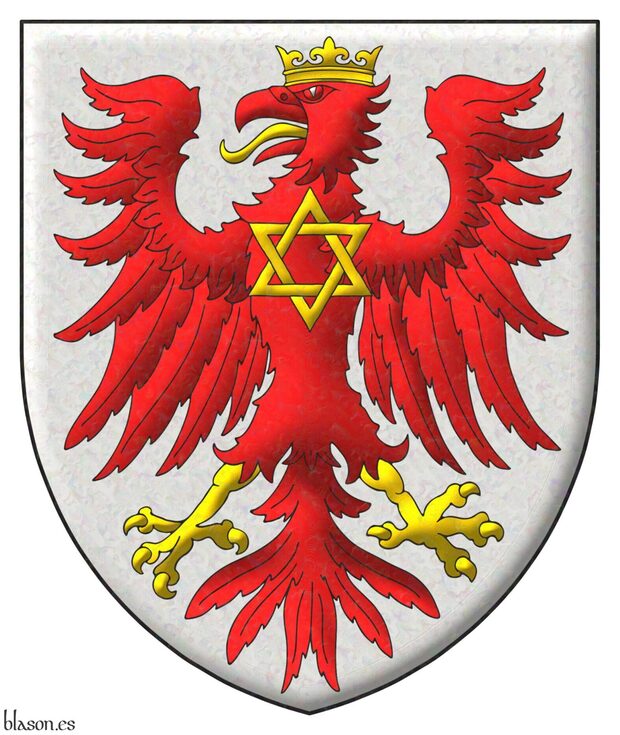
Zurich, Switzerland.
Argent, an eagle displayed Gules, crowned, langued, membered and armed, charged on its chest with a mullet of six points voided, and interlaced Or.
Escudo de plata, un águila de gules, coronada, lampasada, membrada y armada, cargada en su pecho de una estrella de seis puntas, hueca y entrelazada todo de oro.
Illuminated with lights and shadows and with a iridescent finish.
Another version of this blazon «Argent, a eagle displayed Gules, crowned, langued, membered and armed, charged on its chest with a star of David Or».
Blazon keywords: Without divisions, Argent, One, Eagle, Gules, Crowned, Langued, Membered, Armed, Charged, Mullet, Six, Base (lower 1/3), Voided, Interlaced and Or.
Style keywords: Iridescent (nacar), Outlined in sable, Illuminated and Pointed.
Classification: Personal and Created.
Bearer: Sosa-Garcia, Rodolfo.


Tercio Alessandro Farnese
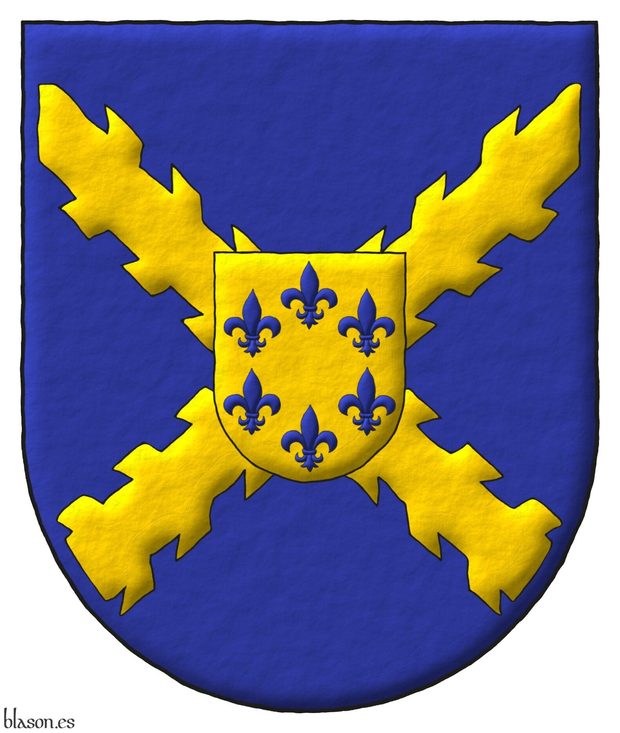
Azure, a cross of Burgundy Or; an inescutcheon Or, six fleurs de lis in orle Azure.
Escudo de azur, una cruz de Borgoña de oro; un escusón de oro, seis flores de lis en orla de azur.
Coat of arms interpreted by me, illuminated with lights and shadows, contoured in Sable, with a semi-circular external shape and with a freehand finishing.
Coat of arms of the Tercio Alessandro Farnese, 4th of the Spanish Legion, emblazoned by me. In honor of Alessandro Farnese, the central inescutcheon bears in orle the 6 fleurs de lis of the Farnese family.
Blazon keywords: Azure, Or, One, Six, Cross of Burgundy, Cross couped, Inescutcheon, Fleur de lis and In orle.
Style keywords: Outlined in sable, Illuminated, Semi-circular and Freehand.
Classification: Military, Interpreted, Boa and Coat of arms.
Bearer: Tercio Alessandro Farnese.


The coat of arms of Rodelo lineage from Galicia in 3 steps
Gules, six wagon-wheels Or, 2, 2, and 2.
Blazon keywords: Gules, Six, Wagon-wheel and Or.
Style keywords: Outlined in sable, Plain tincture, Illuminated, Freehand and Pointed.
Classification: Lineage, Interpreted, Canting, Coat of arms and Schema.
Bearer: Rodelo lineage from Galicia.


Vittorio Gifra
![Arma: palato d’azzurro e d’oro di sei pezzi, alla banda del primo [azzurro] attraversante sul tutto. Paly of six Azure and Or; over all a bend Azure.](../escudo_armas/GifraV.20.MedioPunto.Pergamino.jpg)
Arma: palato d’azzurro e d’oro di sei pezzi, alla banda del primo [azzurro] attraversante sul tutto.
Paly of six Azure and Or; over all a bend Azure.
Blazon keywords: Paly, Six, Azure, Or, Surmounted, Overall (deprecated) and Bend.
Style keywords: Semi-circular, Parchment, Plain tincture and Outlined in sable.
Classification: Coat of arms, Interpreted and Personal.
Bearer: Gifra, Vittorio.


Yñigo-Genio, Rolando
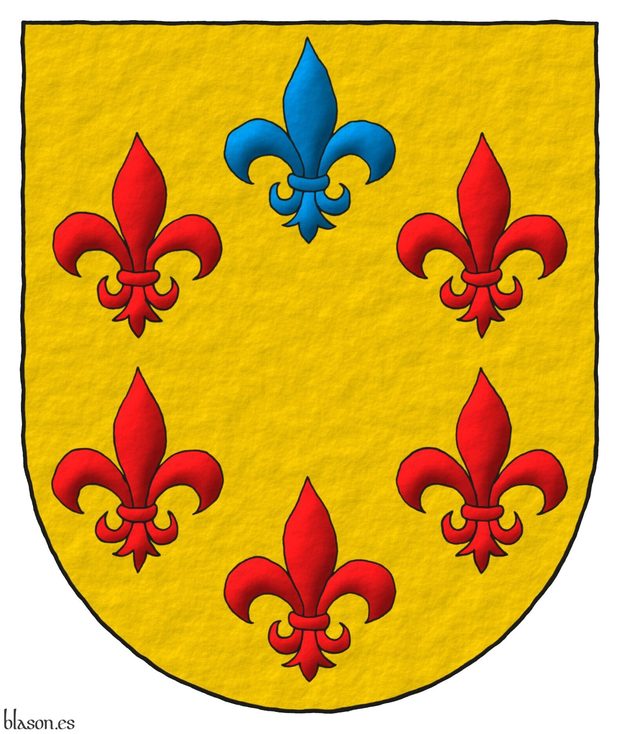
Or, six fleurs de lis in orle, five Gules and one in chief Azure.
I have interpreted this coat of arms with a semi-circular shape; tintures or, azure and gules; outlined with sable; and a freehand finish.
Rolando Yñigo-Genio publish on his website DeviantArt his interpretation of my coat of arms as I publish here in Blason.es I my interpretation of his arms and those of his brothers Noelia Yñigo-Genio and Elias Yñigo-Genio.
Credits: Rolando Yñigo-Genio is the designer of the coat of arms and Antonio Salmerón y Cabañas is the author of the heraldic art.
Blazon keywords: Or, Six, Fleur de lis, Orle, Five, Gules, One, Azure and In chief.
Style keywords: Semi-circular, Freehand and Outlined in sable.
Classification: Interpreted, Personal and Coat of arms.
Bearer: Yñigo-Genio, Rolando.
-
Language
-
Categories of heraldry
-
Divisions of the field
- Without divisions
- Party per pale
- Party per fess
- Party per bend
- Party per bend sinister
- Tierce
- Tierce sinister
- Tierced per pale
- Tierced per fess
- Tierced per bend
- Tierced pallwise inverted
- Quarterly
- Quarterly per saltire
- Gyronny
- Party per fess, the chief per pale
- Party per pale, the sinister per fess
- Party per fess, the base per pale
- Party per pale, the dexter per fess
- Chapé
- Chaussé
- Embrassé
- Contre-embrassé
- Party per chevron
- Enté
- Enté en point
- Flanched
-
Metals
-
Colours
-
Furs
-
Other tinctures
-
Ordinaries and sub-ordinaries
-
Diminutives of the ordinaries
-
Geometric charges
-
Composite ordinaries
-
Inanimate charges from Nature
Atom, Crescent, Diamond, Emerald, Estoile, Increscent, Lightning flash, Moon, Mount, Mullet, Mullet of four points, Orbital, Plough of Ursa Major, Rainbow, Ray of the sun, River, Sea, Snowflake, Sun, Sun in splendour, Sun of May, Trimount and Water.
-
Vegetal charges from Nature
Acorn, Apple, Apple tree, Ash, Bluebonnet, Camellia, Chrysanthemum, Cinquefoil, Cornflower, Dogwood flower, Double rose, Elm, Fleur de lis, Flower, Holm oak, Hop cone, Kapok tree, Laurel, Lily, Linden, Lotus flower, Madonna lily, Oak, Olive tree, Palm tree, Pomegranate, Poplar leaf, Rose, Shamrock, Sunflower, Thistle, Tree, Tulip, Vine and Wheat.
-
Animal charges from Nature
Badger, Bald eagle, Barbel, Barn owl, Bear, Beaver, Beetle, Bighorn sheep, Blackbird, Boar, Brach hound, Bull, Doe, Dog, Dolphin, Dove, Eagle, Elephant, Falcon, Fish, Flame, Fly, Fox, Frog, Goat, Goldfinch, Goose, Heron, Horse, Hummingbird, Jaguar, Lark, Leopard, Lion, Lion passant, Lion rampant guardant, Lioness, Lynx, Male figure, Martlet, Merino ram, Owl, Panther, Parrot, Peacock, Pelican, Pelican in her piety, Puffin, Quetzal, Raven, Roe deer, Rooster, Savage, Seagull, Serpent, She-wolf, Stag, Starling, Talbot, Tyger, Vulture, Warren hound and Wolf.
-
Parts of natural charges
Arm, Beak, Branch, Caboshed, Chest, Claw, Covert, Dorsal fin, Eagle claw, Ermine spot, Escallop, Feather, Foot (palmiped), Foreleg, Forepaw, Hand, Head, Heart, Hoof, Leaf, Neck, Ostrich feather, Palm frond, Paw, Roe deers' attires, Shoulder, Sprig, Stags' attires, Stem, Swallow-tail, Tail, Tail addorsed, Tail fin, Talon, Tooth, Trunk, Trunk (elephant), Two hands clasped, Two wings in vol, Udder, Wheat spike, Wing and Wrist.
-
Artificial charges
Ace of spades, Anchor, Anvil, Arch, Arm vambraced, Armillary sphere, Arrow, Axe, Bell, Bell tower, Beret, Bonfire, Book, Bookmark, Bow, Bridge, Broken, Buckle, Cannon, Cannon dismounted, Cannon port, Canopy roof, Carbuncle, Castle, Celtic Trinity knot, Chain, Chess rooks, Church, Clarion, Clay pot, Closed book, Club, Comb, Compass rose, Conductor's baton, Cord, Covered cup, Crozier, Crucible, Cuffed, Cup, Cyclamor, Dagger, Double vajra, Drum, Ecclesiastical cap, Fanon, Federschwert, Fleam, Four crescents joined millsailwise, Galician granary, Garb, Gauntlet, Geometric solid, Grenade, Halberd, Hammer, Harp, Host, Hourglass, Key, Key ward, Knight, Knot, Lantern, Letter, Line, Loincloth, Menorah, Millrind, Millstone, Millwheel, Monstrance, Mortar, Mullet of six points pierced, Nail, Non-classic artifact, Norman ship, Number, Oar, Oil lamp, Open book, Page, Pair of scales, Parchment, Pestle, Piano, Plough share, Polish winged hussar, Port, Portcullis, Potent, Quill, Ribbon, Rosette of acanthus leaves, Sabre, Sackbut, Sail, Scroll, Scythe, Sheaf of tobacco, Ship, Skirt, Spear, Spear's head, Stairway, Star of David, Step, Sword, Symbol, Tetrahedron, Torch, Tower, Trident, Trumpet, Turret, Two-handed sword, Wagon-wheel, Water-bouget, Wheel, Winnowing fan and With a turret.
-
Immaterial charges
Angel, Archangel, Basilisk, Dragon, Dragon's head, Garuda, Golden fleece, Griffin, Heart enflamed, Mermaid, Our Lady of Mercy, Ouroboros, Paschal lamb, Pegasus, Phoenix, Sacred Heart of Jesus, Saint George, Sea-griffin, Trinity, Triton, Unicorn, Winged hand and Wyvern.
-
External elements
-
Heraldic creations
-
References
-
Formats
-
Keywords on this page
Between, Proper, Pointed, Armed, Armorial roll, Azure, Bendy, Boa, Overall, Wreath, Charged, Upon (wreath), Crest, Five, Crown, Quarterly, Outlined in sable, Dexter, In chief, Coat of arms, Schema, Papal States, Mullet, Barry, Fleur de lis, Personal, Gules, Illuminated, Interpreted, Chief, Mantling, Langued, Motto, Lion, Semi-circular, Or, Argent, Without divisions, Rampant, Religious, Surrounded, Sable, Six, Vert, Grasping, Plain tincture, Freehand, One and Helm.

